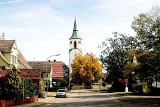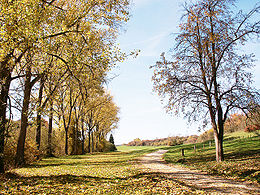
Ostdorf
Encyclopedia

Swabian
Swabian may refer:* to the German region of Swabia ; or* to Swabian German, a dialect spoken in Baden-Württemberg in south-west Germany and adjoining areas See also:...
village within the city limits of Balingen
Balingen
Balingen is a town in Baden-Württemberg, Germany, capital of the district of Zollernalbkreis. It is located nearby the Swabian Alb, approx. 35 km to the south of Tübingen, 35 km northeast of Villingen-Schwenningen, and 60 km southwest of Stuttgart.It is home to the Bizerba and Ideal...
, Germany. Originally a village of its own, Ostdorf and Balingen have grown towards each other since the close of World War II. Finally, in 1971 Ostdorf was included to Balingen as a suburb. It is located 75 kilometers in the south of Stuttgart.
Location
Ostdorf lies in the west of BalingenBalingen
Balingen is a town in Baden-Württemberg, Germany, capital of the district of Zollernalbkreis. It is located nearby the Swabian Alb, approx. 35 km to the south of Tübingen, 35 km northeast of Villingen-Schwenningen, and 60 km southwest of Stuttgart.It is home to the Bizerba and Ideal...
, near the Black Forest
Black Forest
The Black Forest is a wooded mountain range in Baden-Württemberg, southwestern Germany. It is bordered by the Rhine valley to the west and south. The highest peak is the Feldberg with an elevation of 1,493 metres ....
, on a plateau above the Eyach River, a tributary of the Neckar
Neckar
The Neckar is a long river, mainly flowing through the southwestern state of Baden-Württemberg, but also a short section through Hesse, in Germany. The Neckar is a major right tributary of the River Rhine...
river.
The nearest high point is the Warren, 606 meters above sea level. Ostdorf affords spectacular views of the Burg Hohenzollern
Burg Hohenzollern
Hohenzollern Castle is a castle about south of Stuttgart, Germany. It is considered the ancestral seat of the Hohenzollern family, which emerged in the Middle Ages and eventually became German Emperors....
castle, and the Swabian Alb
Swabian Alb
The Swabian Alps or Swabian Jura is a low mountain range in Baden-Württemberg, Germany, extending 220 km from southwest to northeast and 40 to 70 km in width. It is named after the region of Swabia....
mountains to the east. The surrounding area is covered with coniferous forest.
Neighbors
Nearby cities and villages include: Owingen (District of Haigerloch), Engstlatt, Balingen, Geislingen.History
The first settlement in the area was probably around the 7th or 8th Century. The first official mention of Ostdorf was in the 11th century when Albert von Ostdorf sold a fief of the area to the Salem AbbeySalem Abbey
Salem Abbey , also known as Salmansweiler and in Latin as Salomonis Villa, was a very prominent Cistercian monastery in Salem in the district of Bodensee about ten miles from Konstanz, Baden-Württemberg, Germany.-Abbey:The abbey was founded in 1136 by Gunthram of Adelsreute Salem Abbey (Kloster or...
. By 1287 Ostdorf belonged to the Duke of Teck
Duke of Teck
Duke of Teck was, in medieval times, a title borne by the head of a principality named Teck in the Holy Roman Empire, centered around Teck castle in Germany. That territory was held by a branch line of the Zähringen dynasty from 1187 to 1439, known historically as the first House of Teck...
.
After several pledges, in 1317 the village finally became the property of Eberhard I, Count of Württemberg
Eberhard I, Count of Württemberg
Eberhard I was Count of Württemberg from 1279 until his death. He was nicknamed 'der Erlauchte' or the Illustrious Highness.- Life :...
. This is the oldest known connection of Ostdorf with the Württemberg
Württemberg
Württemberg , formerly known as Wirtemberg or Wurtemberg, is an area and a former state in southwestern Germany, including parts of the regions Swabia and Franconia....
kingdom. During the late Middle Ages, Ostdorf was already known for its rural prosperity, and had been known as a farming community. Not until 1949 did it gradually begin to attract industries. In 1971 it was included into the city limits of Balingen. Ostdorf remains, to this day, mostly a farming community.
- 1403: Ostdorf is designated as the location for the newly formed administrative office of the Balingen region within WürttembergWürttembergWürttemberg , formerly known as Wirtemberg or Wurtemberg, is an area and a former state in southwestern Germany, including parts of the regions Swabia and Franconia....
. - 1456: Local courts are mentioned
- 1525: Ostdorf has about 500 residents in 63 buildings. 48 farmers draw the village into the German Peasants' WarGerman Peasants' WarThe German Peasants' War or Great Peasants' Revolt was a widespread popular revolt in the German-speaking areas of Central Europe, 1524–1526. At its height in the spring and summer of 1525, the conflict involved an estimated 300,000 peasants: contemporary estimates put the dead at 100,000...
. - 1592: 225 of Ostdorfs' 662 inhabitants die from bubonic plagueBubonic plaguePlague is a deadly infectious disease that is caused by the enterobacteria Yersinia pestis, named after the French-Swiss bacteriologist Alexandre Yersin. Primarily carried by rodents and spread to humans via fleas, the disease is notorious throughout history, due to the unrivaled scale of death...
, a total of 34%. - 1610: The first mention of a school in Ostdorf.
- 1616: A storm destroys the Tithe BarnTithe barnA tithe barn was a type of barn used in much of northern Europe in the Middle Ages for storing the tithes - a tenth of the farm's produce which had to be given to the church....
(Zehntscheuer), and it is later rebuilt. - 1690: Ostdorf builds its own separate town hall.
- 1787: First mention of a simi-annual cattle market.
- 1816: The Great European FamineFamineA famine is a widespread scarcity of food, caused by several factors including crop failure, overpopulation, or government policies. This phenomenon is usually accompanied or followed by regional malnutrition, starvation, epidemic, and increased mortality. Every continent in the world has...
of 1816, triggered by the eruption of the volcano Mount TamboraMount TamboraMount Tambora is an active stratovolcano, also known as a composite volcano, on the island of Sumbawa, Indonesia. Sumbawa is flanked both to the north and south by oceanic crust, and Tambora was formed by the active subduction zone beneath it. This raised Mount Tambora as high as , making it...
in Indonesia, brings drought and crop failure over large parts of Europe and North America. Also referred to as the Year Without a SummerYear Without a SummerThe Year Without a Summer was 1816, in which severe summer climate abnormalities caused average global temperatures to decrease by about 0.4–0.7 °C , resulting in major food shortages across the Northern Hemisphere...
. - 1820: Three brewery plants are in operation in Ostdorf by this time.
- 1827: School opposite the church is inaugurated.
- 1832: Ostdorf Church expansion.
- 1847: Food shortages due to 3 successive years of poor potato harvests.
- 1852: After another bad harvest, 200 residents immigrate to North America.
- 1867: Gypsum mill on the Kaunter (Bach) opened (abandoned in 1910).
- 1875: Construction of new school begins.
- 1886: Liederkranz founded.
- 1889: Field cleanup
- 1903: Dairy cooperative started.
- 1911: Electrification of the town and water management programs begin.
- 1922: New School and Community Center (in German, FesthalleFesthalleFesthalle is a term used to describe a German arena or community center. The root meaning of the name "Fest-halle" literally means Feast-Hall, but is best translated as Festival Hall or Civic Center...
). - 1930: Volunteer Fire Department founded.
- 1970: Demolition of the old town hall.
- 1971: Ostdorf becomes part of Ortschaftsrat, Balingen.
- 1986: Protestant (Lutheran) community building (formerly Beck'scher yard) is inaugurated.
- 1990: The historic Tithe BarnTithe barnA tithe barn was a type of barn used in much of northern Europe in the Middle Ages for storing the tithes - a tenth of the farm's produce which had to be given to the church....
(Zehntscheuer) built in 1616 burns down. Ostdorf has plans to rebuild it.
Origin of Town Name
A common misconception is that the name Ostdorf means the East-Village (in German Osten-Dorf) and that the village is east of Balingen. The town is actually north-west of Balingen, and the name means "Aust Village."Religion

Protestant Reformation
The Protestant Reformation was a 16th-century split within Western Christianity initiated by Martin Luther, John Calvin and other early Protestants. The efforts of the self-described "reformers", who objected to the doctrines, rituals and ecclesiastical structure of the Roman Catholic Church, led...
, Ostdorf has remained predominantly Protestant Lutheran, and since 1547 has reported to the Dekanat Balingen (Office of the Dean, Balingen). The patron saint of Ostdorf is St. Medardus, a frequently honored saint within farming communities.
The Ostdorf Church
The Evangelische Lutheran Church that currently stands in Ostdorf was built in 1832, and was part of a major repair and expansion project to improve the church structures that were originally built in the 16th century. In 1843 the octoganal bell tower was built, and the copper roof added in 1861. The church has a congregations of 1,800 members and services the Ostdorf and Geislingen communities.It was not until after 1945, due to the influx of displaced Germans after World War II
World War II
World War II, or the Second World War , was a global conflict lasting from 1939 to 1945, involving most of the world's nations—including all of the great powers—eventually forming two opposing military alliances: the Allies and the Axis...
, that the community again began registering Catholics in the city.
Population
| Year | Inhabitants |
|---|---|
| 1525 | 500 |
| 1592 | 438 |
| 1794 | 809 |
| 1820 | 975 |
| 1875 | 992 |
| 1900 | 945 |
| 1959 | 1098 |
| 1992 | 1516 |
| 2005 | 1599 |
Public Institutions
- Bauernmuseum Ostdorf (The Farmers Museum of Ostdorf) exhibits farm implements, rural office furniture, and bedroom furniture from the Balingen Area. It was opened in 1981 in the former historic village school building.
- Protestant Village Kindergarten Meadows
Annual events
- May Day spring concert
- Autumn Festival with the Ostdorf Music Association (usually in October)
- Year-End concert with the Ostdorf Music Association
- The Spritzerfestival with the Ostdorf Volunteer Fire Brigade
- Father's Day celebration of FC Hirschväter
- Folklore evening at the Rathaus (city hall)
- Youth Choir of Apis Balingen and the Parish of Ostdorf Concert (usually three times a year)
Notable Personalities
- Martin HaugMartin HaugMartin Haug was a German orientalist.-Biography:Haug was born at Ostdorf , Württemberg. He became a pupil in the gymnasium at Stuttgart at a comparatively late age, and in 1848 he entered the Eberhard Karls University of Tübingen, where he studied oriental languages, especially Sanskrit...
(1827–1876), German OrientalistOriental studiesOriental studies is the academic field of study that embraces Near Eastern and Far Eastern societies and cultures, languages, peoples, history and archaeology; in recent years the subject has often been turned into the newer terms of Asian studies and Middle Eastern studies...
, born in Ostdorf
Literature
- Stadtverwaltung Balingen. 800 Jahre Ostdorf. Balingen: SV Verlagsdruckerei, 2001. (rough translation - Ostdorf City Administration : 800 years)
----

